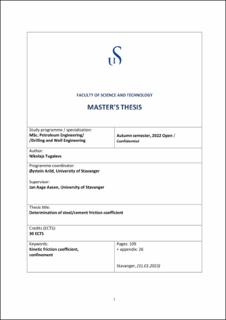Determination of steel/cement friction coefficient
| dc.contributor.advisor | Aasen, Jan Aage | |
| dc.contributor.author | Tugalevs, Nikolajs | |
| dc.date.accessioned | 2023-06-07T15:51:20Z | |
| dc.date.available | 2023-06-07T15:51:20Z | |
| dc.date.issued | 2023 | |
| dc.identifier | no.uis:inspera:124578831:69211329 | |
| dc.identifier.uri | https://hdl.handle.net/11250/3070404 | |
| dc.description.abstract | Two different experimental approaches have been used to determine the kinetic coefficient of friction between carbon steel and concrete made of API class G well cement mixture. First experimental setup consists of sliding steel plate, confined between concrete blocks of a sample while being pushed through them. Kinetic coefficient of friction was in this case calculated from the ratio of vertical load applied to push the plate downward to the normal force exerted perpendicularly and through the friction surface. The second experimental setup was a conventional experiment of concrete block sliding on the inclined surface of steel plate. The angle that the incline makes with horizontal was used to determine the kinetic coefficient of friction in this case. All the constructions necessary for experimental setup in both cases were designed and fabricated at the premises of University of Stavanger as a part of this research. Both experiments have been carried out on each of the six moulded cement samples. Results have shown that confinement results in much higher values of kinetic friction coefficient compared to unconfined sample sliding on an inclined plane. | |
| dc.description.abstract | ||
| dc.language | eng | |
| dc.publisher | uis | |
| dc.title | Determination of steel/cement friction coefficient | |
| dc.type | Master thesis |
Tilhørende fil(er)
Denne innførselen finnes i følgende samling(er)
-
Studentoppgaver (TN-IEP) [336]
Master- og bacheloroppgaver i energi- og petroleumsteknologi
